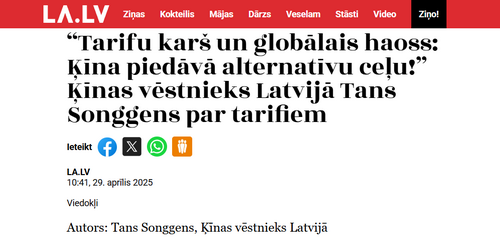
The People’s Republic of China


On April 29, 2025, a signed article by H.E. Mr. Tang Songgen, Chinese Ambassador to Latvia, titled “China provides stability and certainty in the tariff storm”, was published on LA.lv, website of Latvijas Avīze, in Latvian. Full text of its English version is as follows:

Recently, a unilateral tariff hike launched by the White House, under the guise of "reciprocity", shocked the world. The White House insists that the U.S. suffers losses in international trade and, therefore, tries to bring more revenue and trade balance through tariff. But is tariff really as beautiful as imagined?
Instead of great losses as it claimed, the U.S. actually gains a lot in the international trade, especially services trade. Ngozi Okonjo-Iweala, WTO Secretary-General, pointed out that “there is a clear winner” in international services trade: the United States. Services sector accounts for roughly 80% of U.S. GDP and employment, and its exports were worth more than $1 trillion, accounting for 13% of the global total.
China is the biggest contributor to the U.S. service trade surplus indeed, representing roughly 9.5 percent of the total in 2023. When trade in goods, trade in services, and the local sales of domestic enterprises' branches in the other country are all taken into full account, the economic and trade benefits gained by China and the US are roughly balanced.
Jeffrey Sachs and many other U.S. economists pointed out that a country’s trade deficit means that it is spending more than it is producing, and saving less than it is investing. Therefore, tariffs will impoverish the country rather than close the trade deficit. During 2017 to 2020, the US imposed Section 301 Tariff on China, but the tariff did not alleviate US’ trade deficit, which increased from $275.8 billion to $316.5 billion.
Tariff war does not align with principles of free trade and true multilateralism, because any trade is based on agreement between the seller and the buyer, rather than blackmail or threats. Besides, it is more likely to end with a lose-lose scenario, even not a zero-sum one. Analysis shows that taking inflation and shrink in global trade into account, U.S. increased revenue from “reciprocal tariff” would be significantly less than $600 billion a year as the White House expects, left alone the economic recession the tariff may bring to the whole world.
Against this typical move of unilateralism, protectionism and economic bullying, China has already taken resolute measures and will continue to do so to safeguard its legitimate interests, because we are not only safeguarding our own interests, but also defending international trade rules, fairness and justice, so as to prevent the international trade going back to the era of “rules of jungle” when the strong preyed on the weak. China’s position is consistent and clear: We will fight, if fight we must. Our doors are open, if the U.S. wants to talk. Dialogue and negotiation must be based on equality, respect and mutual benefit.
I noticed that there is an opinion that the tariff war resulted from China’s long-term “using” of free market mechanism like the WTO and, consequently, “destroying” it. This opinion, like the “reciprocal tariff” rate formula, is completely wrong.
Facts tell: upon acceding to the WTO, China has honored all its commitments in tariff reduction, and all the tariff reduction commitments for goods were already fulfilled by 2010. The overall tariff level has been reduced from 15.3 percent in 2001 to 9.8 percent currently, very close to the average WTO-bound tariff rate of developed members (9.4 percent). That is definitely not something equivalent to “destroying” the global market mechanism.
Being more and more open is China’s firm commitment to sharing development with the rest of the world. Since 2017, the negative list for foreign investment has been shortened from 93 to 29 items nationwide, and all restrictions on access in the manufacturing sector have been removed. We have also further opened up our medical, financial and telecommunication sectors. In 2024, 59,000 foreign-invested companies were newly established in China, up by 9.9 percent year-on-year. China’s total import and export of goods reached roughly €1.2 trillion in the first quarter of 2025, of which exports exceeded almost €0.7 trillion with a relatively fast growth of 6.9 percent. China-Europe Railway Express has reached a historic landmark of more than 100,000 freight trips.
As the second and third largest economies, China and the EU collectively account for over one third of the global economy and more than a quarter of global trade. Both sides are advocates of economic globalization and trade liberalization, and firm defenders and supporters of the WTO. This year marks the 50th anniversary of China-EU diplomatic relations. We are ready to work with the EU, to share development opportunities, expand opening up and cooperation, and achieve mutual benefits.
As China is advancing modernization on its own path, its vast market brings great opportunities for every country. In a world full of uncertainties, China will continue to seek joining hands rather than throwing punches, removing barriers rather than erecting walls, and promoting connectivity rather than decoupling. Through high-quality development and high-standard opening up, China is an anchor providing stability, certainty, and positive expectation to the world economy in this turbulent time.


